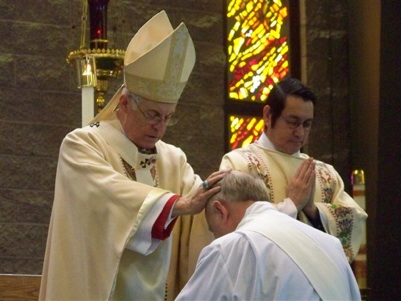 Back at a high point of the Anglican wars, your GetReligionistas could have written a post a week noting how mainstream journalists were chopping multiple decades off the timeline of the conflicts in the Episcopal Church.
The basic idea was that liberal Episcopalians ordained a gay bishop in the tiny diocese of New Hampshire in 2003 and all heckfire broke loose. The essential timeline of the homosexuality conflict alone, meanwhile, would almost certainly have to begin in 1979, when 21 liberal bishops openly rejected the church's traditional teachings on marriage, sex and ordination -- including the bishop who would soon become America's presiding bishop.
Back at a high point of the Anglican wars, your GetReligionistas could have written a post a week noting how mainstream journalists were chopping multiple decades off the timeline of the conflicts in the Episcopal Church.
The basic idea was that liberal Episcopalians ordained a gay bishop in the tiny diocese of New Hampshire in 2003 and all heckfire broke loose. The essential timeline of the homosexuality conflict alone, meanwhile, would almost certainly have to begin in 1979, when 21 liberal bishops openly rejected the church's traditional teachings on marriage, sex and ordination -- including the bishop who would soon become America's presiding bishop.
It's a complicated story and journalists have long struggled to get some of the key facts right.
However, it's time to celebrate a quiet victory. You see, the latest New York Times piece on an issue related to the Anglican wars gets all kind of things right -- including key elements of that complicated timeline. The piece could have gained more clarity by using a few more direct references to dates for pivotal events, but the facts are here for those with the eyes to see them.
The lede, in this report on Rome's new home for Anglo-Catholics:
Opening its doors more widely to disaffected Episcopalians, the Roman Catholic Church has established the equivalent of a nationwide diocese in the United States that former Episcopal priests and congregations can enter together as intact groups, the Vatican announced Sunday.
Converts who join the new entity will be full-fledged Catholics, expected to show allegiance to the pope and oppose contraception and abortion. But they will be allowed to preserve revered verses from the Book of Common Prayer. And, in what one Catholic leader called “an act of generosity,” priests who are married will be exempted from the Catholic requirement of celibacy, though they may not become bishops.
The new grouping, called the Personal Ordinariate of the Chair of St. Peter, will have its headquarters in Houston and be led by Jeffrey N. Steenson, a former Episcopal bishop and father of three who left the church in 2007 and became a Catholic priest in 2009, under an existing exemption for converting Anglicans.
The story could have mentioned that, in effect, the existing ordination structure of the Eastern rite churches had been extended over to the former Anglicans. Married men may be ordained. Once ordained, men may not marry. Bishops are drawn from the ranks of celibate clergy.
All of this is nothing new. Note that the Times mentions that Anglicans had already been entering the Catholic priesthood under similar rules -- since 1980.
And the timeline issue? Here is a key paragraph:
The Episcopal Church is the main American branch of the Anglican Communion, a loose global body whose symbolic head is the archbishop of Canterbury, head of the Church of England. It has been shaken by discord from conservatives who object to the ordination of female priests, the acceptance of bishops with homosexual partners and changes in the liturgy.
It would have been nice to have noted that the ordination of women caused divisions in the ranks in the mid-1970s. The "changes in the liturgy" reference is from the birth and acceptance of the 1979 Book of Common Prayer. The dates would have helped set the framework for these discussions, but at least the facts there there.
Later on, the story establishes another important claim linked to this Vatican action:
Father Steenson said he expected more former Episcopalians to join after they saw how the new group operated. He said that he personally had always longed for closer ties with the Catholics, a feeling that only intensified as the Episcopal Church broke with tradition on female priests and acceptance of homosexuality, dividing the churches further. But he is also overjoyed to preserve elements of the Anglican liturgy, he said. The expectation is that this parallel structure will continue indefinitely.
When the Vatican authorized creation of these entities in 2009, some Anglican leaders, especially in England, expressed concern that it was trying to take advantage of their turmoil. In England, where a similar grouping was formed last year, about 60 priests and more than 1,000 members have joined so far.
But Cardinal Wuerl and Father Hurd said that the system was developed in response to a growing demand.
“There have been Anglican groups requesting this for 30 years,” Father Hurd said. “This is not an effort at poaching or sheep-stealing.”
Now, the Times did elect to base this claim for a 30-year framework on quotes from Catholic officials -- the cardinal and Father Scott Hurd, a former Episcopalian who is already a Catholic priest. That makes it appear, again, that Rome, alone, is claiming this to be true. It would have been easy to have quoted specific actions and dates linked to appeals to Rome by Anglo-Catholics as individuals and groups. The dates on the timeline are well known to leaders on both sides.
However, the key facts are present in this story. The bottom line: Small numbers of Anglicans have appealed for help over several decades. Rome finally responded with a full-fledged, permanent plan for responding.
In other words, this is not a new story. It's an updated entry in a long, long timeline.
PHOTO: Former Episcopal bishop Jeffrey N. Steenson is ordained as a Catholic priest.
